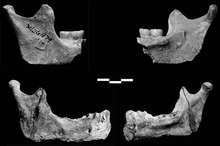Red Deer Cave people
| Red Deer Cave People | |
|---|---|
 | |
| Longlin 1, a partial skull | |
| Scientific classification | |
| Kingdom: | Animalia |
| Phylum: | Chordata |
| Class: | Mammalia |
| Order: | Primates |
| Family: | Hominidae |
| Tribe: | Hominini |
| Genus: | Homo |
| Species: | Undetermined |
The Red Deer Cave People were the most recent known prehistoric archaic human population. Fossils dated to the Bølling-Allerød warming, between about 14,500 to c. 11,500 years ago, were found in Red Deer Cave (Maludong) and Longlin Cave in Southwest China.
The fossils exhibit a mix of archaic and modern features and are tentatively thought to represent a late survival of an archaic human species, or of a hybrid population of Denisovan hominin and modern human descent, or alternatively just "robust early modern humans, probably with affinities to modern Melanesians".[1]
Evidence shows large deer were cooked in the Red Deer Cave, giving the people their name.[2]
Discovery and dating

In 1979, the partial skull of a cave dweller was found in Longlin Cave in the Guangxi region of China. Additional human remains were excavated from Maludong ("Red Deer Cave"; Chinese: 马鹿洞), Yunnan Province, in 1989.
In 2012, the Red Deer Cave fossils were indirectly radiocarbon dated between 14,300 and 12,600 years before present, using charcoal found in the fossil deposits. The single Longlin fossil was dated to 11,500 years before present (mean calibrated age 11,510±255 95% CI).[3]
Anatomy
In spite of their relatively recent age, the fossils exhibit archaic human features.[4] The Red Deer Cave dwellers had distinctive features that differ from modern humans, including: flat face, broad nose, jutting jaw with no chin, large molars, prominent brows, thick skull bones, and moderate-size brain.[5]
Classification
Experts are reluctant to classify the Red Deer Cave people as a new species.[5] They might represent a previously unknown archaic human lineage, or the result of mating between Denisovans and modern humans,[2] or alternatively a thoroughly anatomically modern human population with unusual physiology.[5]
See also
References
- ↑ James Owen (2012-03-14). "Cave Fossil Find: New Human Species or "Nothing Extraordinary"?". National Geographic News.
- 1 2 Barras, Colin (2012-03-14). "Chinese human fossils unlike any known species". New Scientist. Retrieved 2012-03-15.
- ↑ "All of the [Maludong] human remains were recovered from within a series of deposits dating from 14,310±340 cal. yr BP (OZM149; 292 cm depth) to 13,590±160 cal. yr BP (OZM145; 166 cm depth), a period of about 720 years. Moreover, the high fine-grained ferrimagnetic content of the deposits (Text S1), with their high magnetic susceptibility, suggests these were formed under warm, wet conditions, consistent with the Bølling-Allerød interstadial (∼14.7-12.6 ka). Human remains recovered in situ during the 2008 excavation and a reasonably complete calotte (specimen MLDG 1704) derived from a subsection of these deposits dated between 13,990±165 cal. yr BP (OZM148; 235 cm) and 13,890±140 cal. yr BP (OZM146; 200 cm)" Curnoe, D.; Ji, X.; Herries, A. I. R.; Bai, K.; Taçon, P. S. C.; Bao, Z.; Fink, D.; Zhu, Y.; Hellstrom, J.; Luo, Y.; Cassis, G.; Su, B.; Wroe, S.; Hong, S.; Parr, W. C.; Huang, S.; Rogers, N. (2012). Caramelli, David, ed. "Human remains from the Pleistocene-Holocene transition of southwest China Suggest a complex evolutionary history for East Asians". PLoS ONE. 7 (3): e31918. doi:10.1371/journal.pone.0031918. PMC 3303470. PMID 22431968.
- ↑ Curnoe, Darren; Ji, Xueping; Liu, Wu; Bao, Zhende; Taçon, Paul S. C.; Ren, Liang (17 December 2015). "A Hominin Femur with Archaic Affinities from the Late Pleistocene of Southwest China". PLOS ONE. 10 (12): e0143332. doi:10.1371/journal.pone.0143332. PMC 4683062. PMID 26678851.
- 1 2 3 James Owen (2012-03-14). "Cave Fossil Find: New Human Species or "Nothing Extraordinary"?". National Geographic News.
External links

- Defining ‘human’ – new fossils provide more questions than answers (article by Darren Curnoe in The Conversation, March 15, 2012)
- Enigma Man: A Stone Age Mystery (Aired by ABC TV on Tuesday 24 June 2014, 8:30pm)
- Human Timeline (Interactive) – Smithsonian, National Museum of Natural History (August 2016).